Archbishop William E. Lori confirmed that no one who has been credibly accused of sexual abuse of a minor is currently in ministry in the archdiocese, and that he has confidence that all clergy and employees are committed to protecting children and enforcing the archdiocese’s child protection policies.
In a May 11 exclusive interview with the Catholic Review, he expressed his support for some clergy in the Archdiocese of Baltimore who have been identified by a local media report as the officials whose names are redacted in the report of the Maryland Attorney General’s Office regarding clergy sexual abuse in the archdiocese. Archbishop Lori said that the court confidentiality orders remain in place and he respects the court process, so he would not confirm the identifications made by the media.
The archbishop said he has full confidence in the ministry of those identified by the local media outlet because the men – Monsignors J. Bruce Jarboe, Michael G. Schluepner and Richard W. Woy – were “in some sense, the architects of the safe environment policies and procedures that we have in place today.” The officials in the attorney general’s report were not accused of abuse themselves, and their names were redacted by the Baltimore City Circuit Court prior to the report’s release.
Archbishop Lori added that these men have subsequently served as pastors of parishes where they have faithfully implemented those policies and undergone safe environment training. They and their parishes have been audited for compliance with archdiocesan policies. “They themselves have seen to it that the background checks, reporting requirements and all the other policies in the archdiocese have been followed faithfully, and so, I believe that it’s important for me to support the good work that they have done,” Archbishop Lori said.
He said the men who were identified were “part of a generation of leadership that worked very hard to bring about a culture change in the archdiocese – a culture change to root out the evil of sexual abuse and to prevent attempts to cover up failures or to hide abusers.” Their work led to innovations such as the establishment of the Office of Child and Youth Protection by Monsignor Woy, publishing a list of credibly accused priests and brothers, and establishing and implementing policies of screening and training for tens of thousands of employees and volunteers and members of the clergy.
The archdiocese significantly enhanced its accountability to the faithful and to the public at large beginning in 1993 by consistently reporting all allegations of child sexual abuse to law enforcement, regardless of the victim-survivor’s age when the allegation was brought forward.
“Certainly, they didn’t have a playbook,” the archbishop said. While he did not confirm that the names mentioned in news reports were those redacted in the AG’s report, he said, “Certainly, there was an evolution in our policies and procedures, but these priests identified in the (news) paradoxically were the ones who really helped the archdiocese come to the point where it is today, which is zero tolerance, tremendous efforts to prevent abuse and great transparency and reporting.”
Archbishop Lori reached out May 12 to parishes where these priests are assigned for ministry to reinforce his confidence in them.
Messages regarding Monsignor Jarboe were sent to St. Ann in Hagerstown, where he currently serves as pastor, and Immaculate Conception in Towson, where he was to have become pastor in July. The archbishop told both communities that Monsignor Jarboe will stay at St. Ann, rather than change parishes as was previously announced, citing the distraction caused by incomplete news coverage.
He also sent messages of support to St. Elizabeth Ann Seton in Crofton, where Monsignor Woy serves as pastor, and Our Lady of Grace in Parkton, where Monsignor Schluepner, who is retired, celebrates Mass regularly.
The archbishop said that in their roles at the time discussed in the news report, Monsignors Jarboe, Schluepner and Woy were part of the team reporting accusations to law enforcement.
“They did, and as the reporting laws evolved, we followed those reporting laws in the Archdiocese of Baltimore,” Archbishop Lori said. “I’m not sure that’s entirely clear from the coverage, but we have done that, and since 2002 we have put out the names of those who we have known, and we have expanded that list as new information has come to our attention.”
He said the priests’ record “is very much opposite of a record of covering up. I think they have helped the archdiocese come to a point of great transparency.”
The AG’s report was the result of a four-year investigation and noted that 156 clergy or employees of the archdiocese and its parishes and schools abused more than 600 victims going back as far as 80 years.
The archbishop said distilling the 450-page report from the Attorney General’s Office, as well as the archdiocesan response, is a challenge. “It’s very difficult, I think, for the media to capture all that is in it. I would just say that the media coverage in general has not captured all that the archdiocese has done over decades to address sexual abuse, to root it out from our midst and to strive mightily to protect children and young people from harm,” he said.
Archbishop Lori also noted that some are calling for the archdiocese to release the names of 10 clergy or others affiliated with the church accused of abuse whose names were redacted in the report when it was released April 5. He said the archdiocese has cooperated with Maryland laws and state authorities, and it cooperated with the preparation of the attorney general’s report by providing hundreds of thousands of documents. “And now we are cooperating with the court process. And we are under a court order not to do that (release the names that are redacted). …
“When and if the names are out, when and if the judge decides to unredact the names, we have no problem with that. But that is not my decision to make. It was the judge who redacted them, and he gave us a court order. And in spite of what has been said, we are not at liberty to violate a court order. We’re just not. That’s simply a fact,” the archbishop said.
Archbishop Lori acknowledged that cultural change in any large organization doesn’t happen overnight, and the Roman Catholic Church is no exception to that. In the State of Maryland and in the Archdiocese of Baltimore, the requirements for reporting allegations of child sexual abuse – and even the child protection laws themselves – evolved over the years. The behavioral sciences also evolved their understanding of the way sexual abuse inflicts lasting damage to victim-survivors.
“I think the archdiocese has worked really hard to respond to that changing landscape and to do so as responsibly as it could,” the archbishop said. “Obviously when we look back in time, we see that we have learned things over these decades that we did not know when the process of culture change began; that is not surprising and that’s true, I think, in every organization.”
He added that improvements in the archdiocesan response and pastoral outreach continue today as the archdiocese consults with the Independent Review Board, a group of mostly lay professionals who advise the archbishop and archdiocese on child protection, other outside experts and the archdiocese’s own expertise from dealing with this for a long time.
“Pastoral practice evolves and develops when we pay attention prayerfully and discerningly to our experience and we’ve been doing all of those things consistently and we will continue to do them,” Archbishop Lori said.
The archdiocese’s response to child sexual abuse within its ranks over the eight decades covered by the attorney general’s report has grown much stronger. “We see that the church’s response in those early years of the report was woefully inadequate. There was a lot that was wrong with it. The result of those inadequate policies and procedures was a lot of harm to a lot of people. We acknowledge that and we grieve for those who have been harmed,” he said.
However, in the mid-1980s, the archdiocese “began to put policies in place, beginning to take priests out of ministry. And from there the response got stronger.”
It was not until 2002 that the U.S. Conference of Catholic Bishops established the Charter for the Protection of Children and Young People and its accompanying Essential Norms for Diocesan/Eparchial Policies Dealing with Allegations of Sexual Abuse of Minors by Priests or Deacons. He said some of the early policies in the Archdiocese of Baltimore blazed trails that became part of the Charter and Norms.
The Archdiocese of Baltimore was the second in the country to publish a list of names of credibly accused clergy, which is not required by law, and one of the first to establish an Independent Review Board and an Office of Child and Youth Protection. It was the first diocese in the country to set up a third-party system to report misconduct or malfeasance by bishops, a precursor of a system adopted later nationwide by the USCCB.
Voluntarily publishing a list of credibly accused clergy has a two-fold purpose: “We have done it so that parishioners would know the truth and we’ve done it so that victims who may have been harmed would realize that perhaps they weren’t the only ones and would feel encouraged to come forward,” Archbishop Lori said. That list, however, is not the only way in which the archdiocese publicly communicates about credible allegations of abuse against its clergy, lay employees and volunteers.
“We have progressively strengthened training and prevention programs. When you think about the early programs that we had, they were OK. But I think what we have today, the Virtus program, is superior and it’s delivered with contemporary technology as well.”
In a letter to be sent to the faithful of the archdiocese May 12, the archbishop encouraged those interested in the church’s response to the attorney general’s report to read his pastoral letter, “Apology, Healing and Action: The Church’s Work to Repair the Sacred Trust,” available in English and Spanish, and an FAQ about the redacted report on the archdiocesan website.
In the May 12 letter, the archbishop also asked the members of the archdiocese “to join me in praying that this public accounting of historical failures will bring peace to the faithful, healing to victim-survivors and reconciliation to the church.”
Email Christopher Gunty at editor@CatholicReview.org
Also see
Copyright © 2023 Catholic Review Media









